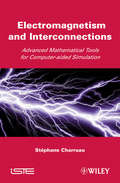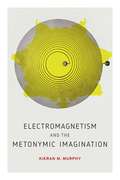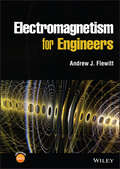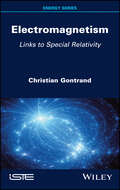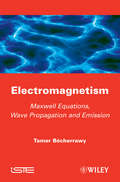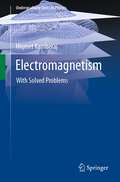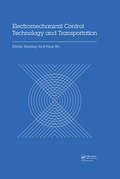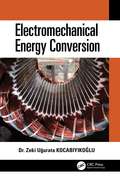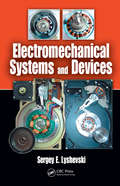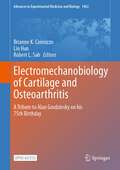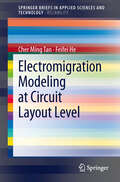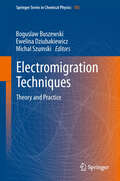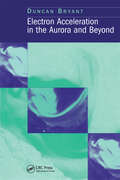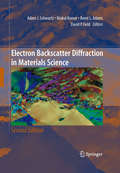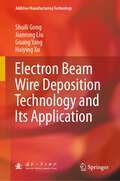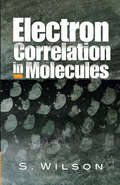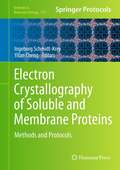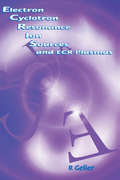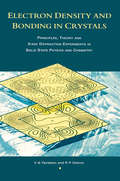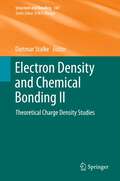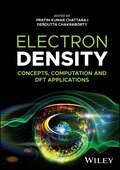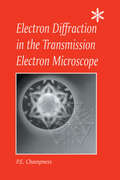- Table View
- List View
Electromagnetism and Interconnections: Advanced Mathematical Tools for Computer-aided Simulation
by Stephane CharruauThis book covers the theoretical problems of modeling electrical behavior of the interconnections encountered in everyday electronic products. The coverage shows the theoretical tools of waveform prediction at work in the design of a complex and high-speed digital electronic system. Scientists, research engineers, and postgraduate students interested in electromagnetism, microwave theory, electrical engineering, or the development of simulation tools software for high speed electronic system design automation will find this book an illuminating resource.
Electromagnetism and the Metonymic Imagination (AnthropoScene #4)
by Kieran M. MurphyHow does the imagination work? How can it lead to both reverie and scientific insight? In this book, Kieran M. Murphy sheds new light on these perennial questions by showing how they have been closely tied to the history of electromagnetism.The discovery in 1820 of a mysterious relationship between electricity and magnetism led not only to technological inventions—such as the dynamo and telegraph, which ushered in the “electric age”—but also to a profound reconceptualization of nature and the role the imagination plays in it. From the literary experiments of Edgar Allan Poe, Honoré de Balzac, Villiers de l’Isle-Adam, and André Breton to the creative leaps of Michael Faraday and Albert Einstein, Murphy illuminates how electromagnetism legitimized imaginative modes of reasoning based on a more acute sense of interconnection and a renewed interest in how metonymic relations could reveal the order of things.Murphy organizes his study around real and imagined electromagnetic devices, ranging from Faraday’s world-changing induction experiment to new types of chains and automata, in order to demonstrate how they provided a material foundation for rethinking the nature of difference and relation in physical and metaphysical explorations of the world, human relationships, language, and binaries such as life and death. This overlooked exchange between science and literature brings a fresh perspective to the critical debates that shaped the nineteenth century.Extensively researched and convincingly argued, this pathbreaking book addresses a significant lacuna in modern literary criticism and deepens our understanding of both the history of literature and the history of scientific thinking.
Electromagnetism and the Metonymic Imagination (AnthropoScene: The SLSA Book Series #4)
by Kieran M. MurphyHow does the imagination work? How can it lead to both reverie and scientific insight? In this book, Kieran M. Murphy sheds new light on these perennial questions by showing how they have been closely tied to the history of electromagnetism.The discovery in 1820 of a mysterious relationship between electricity and magnetism led not only to technological inventions—such as the dynamo and telegraph, which ushered in the "electric age"—but also to a profound reconceptualization of nature and the role the imagination plays in it. From the literary experiments of Edgar Allan Poe, Honoré de Balzac, Villiers de l’Isle-Adam, and André Breton to the creative leaps of Michael Faraday and Albert Einstein, Murphy illuminates how electromagnetism legitimized imaginative modes of reasoning based on a more acute sense of interconnection and a renewed interest in how metonymic relations could reveal the order of things.Murphy organizes his study around real and imagined electromagnetic devices, ranging from Faraday’s world-changing induction experiment to new types of chains and automata, in order to demonstrate how they provided a material foundation for rethinking the nature of difference and relation in physical and metaphysical explorations of the world, human relationships, language, and binaries such as life and death. This overlooked exchange between science and literature brings a fresh perspective to the critical debates that shaped the nineteenth century.Extensively researched and convincingly argued, this pathbreaking book addresses a significant lacuna in modern literary criticism and deepens our understanding of both the history of literature and the history of scientific thinking.
Electromagnetism for Engineers
by Andrew J. FlewittElectromagnetism for Engineers An easily accessible textbook to introduce the power of electromagnetism Electromagnetism can be a difficult subject to grasp and to teach. Much of what we take for granted in modern life is enabled by electromagnetic effects, but it isn’t always easy to understand the impact of electromagnetism compared to other areas of engineering, such as mechanics, which are more tangibly observed and felt. Although electromagnetism is a crucial and important branch of physics with elegant mathematics, many students can find the study of electromagnetism inaccessible. It is crucial for students of electrical and electronic engineering and physics to have a strong understanding of electromagnetism and how it impacts communications, power generation and transmission, semiconductor devices, motors, and more. Electromagnetism for Engineers aims to develop a student’s understanding of electromagnetism in the context of real effects and how they apply to such applications, whilst maintaining the sophistication of the mathematics that can be used to give deeper insight. It begins by describing the fundamentals of electromagnetism before a more detailed discussion of the basic concepts developed for specific application areas. It then considers the application of electromagnetism to transmission lines, antennas, and waveguides. Electromagnetism for Engineers readers will find: A unique approach that illustrates the link between real-life applications and fundamental theory of electromagnetism Clear, concise language to help students gain a full understanding of the subject Carefully designed figures to illustrate points throughout the book Accompanying website at www.wiley.com/go/flewitt1418 Electromagnetism for Engineers has been written as a textbook for undergraduates studying electronic or electrical engineering. The manual can also be of interest to physics students and??to graduate-level students desirous of having a general book on electromagnetism. It is also a useful reference for professional engineers looking for a refresher on the fundamentals of electromagnetism.
Electromagnetism: Lectures on Theoretical Physics
by David TongThere are four forces in our universe. Two act only at the very smallest scales and one only at the very biggest. For everything inbetween, there is electromagnetism. The theory of electromagnetism is described by four gloriously simple and beautiful vector calculus equations known as the Maxwell equations. These are the first genuinely fundamental equations that we meet in our physics education and they survive, essentially unchanged, in our best modern theories of physics. They also serve as a blueprint for what subsequent laws of physics look like. This textbook takes us on a tour of the Maxwell equations and their many solutions. It starts with the basics of electric and magnetic phenomena and explains how their unification results in waves that we call light. It then describes more advanced topics such as superconductors, monopoles, radiation, and electromagnetism in matter. The book concludes with a detailed review of the mathematics of vector calculus.
Electromagnetism: Links to Special Relativity
by Christian GontrandElectromagnetism: Links to Special Relativity
Electromagnetism: Maxwell Equations, Wave Propagation and Emission (Wiley-iste Ser.)
by Tamer BecherrawyThis book deals with electromagnetic theory and its applications at the level of a senior-level undergraduate course for science and engineering. The basic concepts and mathematical analysis are clearly developed and the important applications are analyzed. Each chapter contains numerous problems ranging in difficulty from simple applications to challenging. The answers for the problems are given at the end of the book. Some chapters which open doors to more advanced topics, such as wave theory, special relativity, emission of radiation by charges and antennas, are included. The material of this book allows flexibility in the choice of the topics covered. Knowledge of basic calculus (vectors, differential equations and integration) and general physics is assumed. The required mathematical techniques are gradually introduced. After a detailed revision of time-independent phenomena in electrostatics and magnetism in vacuum, the electric and magnetic properties of matter are discussed. Induction, Maxwell equations and electromagnetic waves, their reflection, refraction, interference and diffraction are also studied in some detail. Four additional topics are introduced: guided waves, relativistic electrodynamics, particles in an electromagnetic field and emission of radiation. A useful appendix on mathematics, units and physical constants is included. Contents 1. Prologue. 2. Electrostatics in Vacuum. 3. Conductors and Currents. 4. Dielectrics. 5. Special Techniques and Approximation Methods. 6. Magnetic Field in Vacuum. 7. Magnetism in Matter. 8. Induction. 9. Maxwell’s Equations. 10. Electromagnetic Waves. 11. Reflection, Interference, Diffraction and Diffusion. 12. Guided Waves. 13. Special Relativity and Electrodynamics. 14. Motion of Charged Particles in an Electromagnetic Field. 15. Emission of Radiation.
Electromagnetism: With Solved Problems (Undergraduate Texts in Physics)
by Hiqmet KamberajAny curriculum involving science and/or engineering will eventually find itself entering the realm of physics. This book seeks to introduce students to a number of the fundamental concepts in physics and illustrate how different theories were developed out of physical observations and phenomena. The book presents multi-chapter sections on electrostatics, magnetism and electromagnetic waves, with eyes on both the past and the future, touching, along the way, on Coulomb, Gauss, Maxwell, Ohm, Biot-Savart, Ampere, Faraday, Fresnel and Lorentz. The book also contains an appendix that provides the reader with a portion of the mathematical background of vector analysis and vector differential operators. The book approaches its topics through a focus on examples and problem-solving techniques, illustrating vividly how physical theories are applied to problems in engineering and science. The book is primarily aimed at undergraduate students in these two fields, but it also features chapters that are geared towards senior undergraduates working on their final year theses.
Electromechanical Control Technology and Transportation: Proceedings of the 2nd International Conference on Electromechanical Control Technology and Transportation (ICECTT 2017), January 14-15, 2017, Zhuhai, China
by Feng Wu Xiaoling JiaThe 2017 2nd International Conference on Electromechanical Control Technology and Transportation (ICECTT 2017) was held on January 14–15, 2017 in Zhuhai, China. ICECTT 2017 brought together academics and industrial experts in the field of electromechanical control technology and transportation to a common forum. The primary goal of the conference was to promote research and developmental activities in electromechanical control technology and transportation. Another goal was to promote exchange of scientific information between researchers, developers, engineers, students, and practitioners working all around the world. The conference will be held every year thus making it an ideal platform for people to share views and experiences in electromechanical control technology and transportation and related areas.
Electromechanical Energy Conversion
by Zeki Uğurata KocabiyikoğluThis book is intended to be a textbook for undergraduate students studying electrical and electronic engineering in universities and colleges. Therefore, the level and amount of the knowledge to be transferred to the reader is kept to as much as what can be taught in one academic semester of a university or a college course. Although the subject is rather classical and somehow well established in some respects, it is vast and can be difficult to grasp if unnecessary details are not avoided. This book is aimed to give the reader just what is necessary - with plenty of short and easily understandable examples and drawings, figures, and tables. A course on electromechanical energy conversion is a necessity in all universities and colleges entitled to grant a license for electrical engineering. This book is aimed at meeting the requirements of this essential subject by providing necessary information to complete the course. A compact chapter is included with figures and tables on energy and the restraints on its production brought about by global climate change. A new approach has been tried for some of the classic subjects including magnetic circuits and electrical machines together with today’s much-used motors.
Electromechanical Systems and Devices
by Sergey Edward LyshevskiStudents entering today's engineering fields will find an increased emphasis on practical analysis, design, and control. They must be able to translate their advanced programming abilities and sound theoretical backgrounds into superior problem-solving skills. Electromechanical Systems and Devices facilitates the creation of critical problem-solvin
Electromechanobiology of Cartilage and Osteoarthritis: A Tribute to Alan Grodzinsky on his 75th Birthday (Advances in Experimental Medicine and Biology #1402)
by Brianne K. Connizzo Lin Han Robert L. SahThis is an open access book. In honor of his 75th birthday, we reflect on the impact of the pioneering work of Alan Grodzinsky and his laboratory. This volume includes in-depth discussions of tissue electromechanics, mechanobiology and biomechanics, and matrix biology in addition to the latest advancements in understanding the pathogenesis, progression and treatment of osteoarthritis. Unique to this volume, we overview decades of groundbreaking research that set the stage for the latest efforts in the field, highlighting the legacy of one researcher and their trainees.
Electromigration Modeling at Circuit Layout Level
by Cher Ming Tan Feifei HeIntegrated circuit (IC) reliability is of increasing concern in present-day IC technology where the interconnect failures significantly increases the failure rate for ICs with decreasing interconnect dimension and increasing number of interconnect levels. Electromigration (EM) of interconnects has now become the dominant failure mechanism that determines the circuit reliability. This brief addresses the readers to the necessity of 3D real circuit modelling in order to evaluate the EM of interconnect system in ICs, and how they can create such models for their own applications. A 3-dimensional (3D) electro-thermo-structural model as opposed to the conventional current density based 2-dimensional (2D) models is presented at circuit-layout level.
Electromigration Techniques
by Michal Szumski Ewelina Dziubakiewicz Boguslaw BuszewskiThe book provides the broad knowledge on electromigration techniques including: theory of CE, description of instrumentation, theory and practice in micellar electrokinetic chromatography, isotachophoresis, capillary isoelectric focusing, capillary and planar electrochromatography (including description of instrumentation and packed and monolithic column preparation), 2D-gel electrophoresis (including sample preparation) and lab-on-a-chip systems. The book also provides the most recent examples of applications including food, environmental, pharmaceutical analysis as well as proteomics.
Electron Acceleration in the Aurora and Beyond
by D BryantHow did electrons in the high atmosphere and space around the Earth come to acquire their speeds and energies?This intriguing question lies at the heart of understanding how high-energy electrons create the spectacular displays of the ^IAurora Borealis and ^IAurora Australis. Electron Acceleration in the Aurora and Beyond explores the mysteries
Electron Backscatter Diffraction in Materials Science
by Brent L. Adams Mukul Kumar Adam J. Schwartz David P. FieldElectron backscatter diffraction is a very powerful and relatively new materials characterization technique aimed at the determination of crystallographic texture, grain boundary character distributions, lattice strain, phase identification, and much more. The purpose of this book is to provide the fundamental basis for electron backscatter diffraction in materials science, the current state of both hardware and software, and illustrative examples of the applications of electron backscatter diffraction to a wide-range of materials including undeformed and deformed metals and alloys, ceramics, and superconductors. The text has been substantially revised from the first edition, and the authors have kept the format as close as possible to the first edition text. The new developments covered in this book include a more comphrensive coverage of the fundamentals not covered in the first edition or other books in the field, the advances in hardware and software since the first edition was published, and current examples of application of electron backscatter diffraction to solve challenging problems in materials science and condensed-matter physics.
Electron Beam Wire Deposition Technology and Its Application (Additive Manufacturing Technology)
by Guang Yang Shuili Gong Jianrong Liu Haiying XuThis book provides a systematic and comprehensive introduction to the technical principles, materials, processes, and equipment of the electron beam wire deposition technology (EBWD), while focusing on the research results of the author’s scientific research team engaged in this technology in China. It mainly introduces the conceptual connotation, principle, and characteristics of the EBWD technology, its position and function in the additive manufacturing technology system, the direction and trend of technological development at home and abroad, the fundamentals and application results of the EBWD technology, including technical principles, equipment technology, special materials, manufacturing technology, quality testing, and application practices. So this book can serve as a reference book for teachers, students, and scientific researchers in scientific research institutions who are engaged in relevant studies.
Electron Correlation in Molecules
by S. WilsonElectron correlation effects are of vital significance to the calculation of potential energy curves and surfaces, the study of molecular excitation processes, and in the theory of electron-molecule scattering. This text describes methods for addressing one of theoretical chemistry's central problems, the study of electron correlation effects in molecules.Although the energy associated with electron correlation is a small fraction of the total energy of an atom or molecule, it is of the same order of magnitude as most energies of chemical interest. If the solution of quantum mechanical equations from first principles is to provide an accurate quantitative prediction, reliable techniques for the theoretical determination of the effect of electron correlation on molecular properties are therefore important. To that end, this text explores molecular electronic structure, independent electron models, electron correlation, the linked diagram theorem, group theoretical aspects, the algebraic approximation, and truncation of expansions for expectation values.
Electron Crystallography of Soluble and Membrane Proteins
by Ingeborg Schmidt-Krey Yifan ChengThe basic principle of electron crystallography is to calculate a 3D density map by combining the amplitudes obtained from electron diffraction patterns with the experimental phases calculated from images of two-dimensional crystals of membrane or soluble proteins. This technology is very well developed and has produced a number of atomic models of membrane proteins in a lipid environment. Focused on comprehensive experimental protocols, Electron Crystallography of Soluble and Membrane Proteins: Methods and Protocols covers the entire range of techniques used in electron crystallography, including protein sample preparation, 2D crystallization, and screening in negative stain over electron cryo-microscopy (cryo-EM) and data processing, as well as modeling of conformational changes. Additional chapters provide perspective on past, present, and future challenges as well as complementary methods. Written for the popular Methods in Molecular BiologyTM series, the work contains the kind of detailed descriptions and implementation advice necessary to ensure successful results. Comprehensive and cutting-edge, Electron Crystallography of Soluble and Membrane Proteins: Methods and Protocols serves laboratories new to the methods as well as state-of-the-art facilities pursuing this exciting area of protein science.
Electron Cyclotron Resonance Ion Sources and ECR Plasmas
by R GellerAcknowledged as the "founding father" of and world renowned expert on electron cyclotron resonance sources Richard Geller has produced a unique book devoted to the physics and technicalities of electron cyclotron resonance sources. Electron Cyclotron Resonance Ion Sources and ECR Plasmas provides a primer on electron cyclotron phenomena in ion sour
Electron Density and Bonding in Crystals: Principles, Theory and X-ray Diffraction Experiments in Solid State Physics and Chemistry
by V.G Tsirelson R.P OzerovElectron Density and Bonding in Crystals: Principles, Theory and X-Ray Diffraction Experiments in Solid State Physics and Chemistry provides a comprehensive, unified account of the use of diffraction techniques to determine the distribution of electrons in crystals. The book discusses theoretical and practical techniques, the application of electron density studies to chemical bonding, and the determination of the physical properties of condensed matter.The book features the authors' own key contributions to the subject as well a thorough, critical summary of the extensive literature on electron density and bonding. Logically organized, coverage ranges from the theoretical and experimental basis of electron density determination to its impact on investigations of the nature of the chemical bond and its uses in determining electromagnetic and optical properties of crystals. The main text is supplemented by appendices that provide clear, concise guidance on aspects such as systems of units, quantum theory of atomic vibrations, atomic orbitals, and creation and annihilation operators. The result is a valuable compendium of modern knowledge on electron density distributions, making this reference a standard for crystallographers, condensed matter physicists, theoretical chemists, and materials scientists.
Electron Density and Chemical Bonding I
by Dietmar StalkeD. Stalke, U. Flierler: More than Just Distances from Electron Density Studies.- A.O. Madsen: Modeling and Analysis of Hydrogen Atoms.- B.B. Iversen/J. Overgaard: Charge Density Methods in Hydrogen Bond Studies.- U. Flierler, D. Stalke: Some Main Group Chemical Perceptions in the Light of Experimental Charge Density Investigations.- D. Leusser: Electronic Structure and Chemical Properties of Lithium Organics Seen Through the Glasses of Charge Density.- L. J. Farrugia, P. Macchi: Bond Orders in Metal-Metal Interactions Through Electron Density Analysis.- W. Scherer, V. Herz, Ch. Hauf: On the Nature of β-Agostic Interactions: A Comparison Between the Molecular Orbital and Charge Density Picture.
Electron Density: Concepts, Computation and DFT Applications
by Pratim Kumar Chattaraj Debdutta ChakrabortyDiscover theoretical, methodological, and applied perspectives on electron density studies and density functional theory Electron density or the single particle density is a 3D function even for a many-electron system. Electron density contains all information regarding the ground state and also about some excited states of an atom or a molecule. All the properties can be written as functionals of electron density, and the energy attains its minimum value for the true density. It has been used as the basis for a quantum chemical computational method called Density Functional Theory, or DFT, which can be used to determine various properties of molecules. DFT brings out a drastic reduction in computational cost due to its reduced dimensionality. Thus, DFT is considered to be the workhorse for modern computational chemistry, physics as well as materials science. Electron Density: Concepts, Computation and DFT Applications offers an introduction to the foundations and applications of electron density studies and analysis. Beginning with an overview of major methodological and conceptual issues in electron density, it analyzes DFT and its major successful applications. The result is a state-of-the-art reference for a vital tool in a range of experimental sciences. Readers will also find: A balance of fundamentals and applications to facilitate use by both theoretical and computational scientists Detailed discussion of topics including the Levy-Perdew-Sahni equation, the Kohn Sham Inversion problem, and more Analysis of DFT applications including the determination of structural, magnetic, and electronic properties Electron Density: Concepts, Computation and DFT Applications is ideal for academic researchers in quantum, theoretical, and computational chemistry and physics.
Electron Diffraction in the Transmission Electron Microscope: Electron Diffraction in the Transmission Electron Microscope
by P.E. ChampnessThis book is a practical guide to electron diffraction in the transmission electron microscope (TEM). Case studies and examples are used to provide an invaluable introduction to the subject for those new to the technique. The book explains the basic methods used to obtain diffraction patterns with the TEM. The numerous illustrations aid the understanding of the conclusions reached.
Electron Energy Loss Spectroscopy (Microscopy Handbooks)
by R. BrydsonElectron Energy Loss Spectroscopy (EELS) is a high resolution technique used for the analysis of thin samples of material. The technique is used in many modern transmission electron microscopes to characterise materials. This book provides an up-to-date introduction to the principles and applications of EELS. Specific topics covered include, theory of EELS, elemental quantification, EELS fine structure, EELS imaging and advanced techniques.
